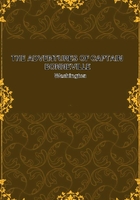
第114章 Irving’s Bonneville - Chapter 41(1)
A voyage in a bull boat.
IT was about the middle of August (1833) that Mr. Nathaniel J. Wyeth, as the reader mayrecollect, launched his bull boat at the foot of the rapids of the Bighorn, and departed in advanceof the parties of Campbell and Captain Bonneville. His boat was made of three buffalo skins,stretched on a light frame, stitched together, and the seams paid with elk tallow and ashes. Itwas eighteen feet long, and about five feet six inches wide, sharp at each end, with a roundbottom, and drew about a foot and a half of water-a depth too great for these upper rivers, whichabound with shallows and sand-bars. The crew consisted of two half-breeds, who claimed to bewhite men, though a mixture of the French creole and the Shawnee and Potawattomie. Theyclaimed, moreover, to be thorough mountaineers, and first-rate hunters -- the common boast ofthese vagabonds of the wilderness. Besides these, there was a Nez Perce lad of eighteen years ofage, a kind of servant of all work, whose great aim, like all Indian servants, was to do as littlework as possible; there was, moreover, a half-breed boy, of thirteen, named Baptiste, son of aHudson's Bay trader by a Flathead beauty; who was travelling with Wyeth to see the world andcomplete his education. Add to these, Mr. Milton Sublette, who went as passenger, and we havethe crew of the little bull boat complete.
It certainly was a slight armament with which to run the gauntlet through countriesswarming with
hostile hordes, and a slight bark to navigate these endless rivers, tossing and pitching downrapids,
running on snags and bumping on sand-bars; such, however, are the cockle-shells with whichthese
hardy rovers of the wilderness will attempt the wildest streams; and it is surprising what roughshocks and thumps these boats will endure, and what vicissitudes they will live through. Theirduration, however, is but limited; they require frequently to be hauled out of the water and dried,to
prevent the hides from becoming water-soaked; and they eventually rot and go to pieces.
The course of the river was a little to the north of east; it ran about five miles an hour, over agravelly
bottom. The banks were generally alluvial, and thickly grown with cottonwood trees,intermingled
occasionally with ash and plum trees. Now and then limestone cliffs and promontories advancedupon the river, making picturesque headlands. Beyond the woody borders rose ranges of nakedhills.
Milton Sublette was the Pelorus of this adventurous bark; being somewhat experienced inthis wild
kind of navigation. It required all his attention and skill, however, to pilot her clear of sand-barsand
snags of sunken trees. There was often, too, a perplexity of choice, where the river branched intovarious channels, among clusters of islands; and occasionally the voyagers found themselvesaground
and had to turn back.
It was necessary, also, to keep a wary eye upon the land, for they were passing through theheart of
the Crow country, and were continually in reach of any ambush that might be lurking on shore.
The
most formidable foes that they saw, however, were three grizzly bears, quietly promenadingalong
the bank, who seemed to gaze at them with surprise as they glided by. Herds of buffalo, also,were
moving about, or lying on the ground, like cattle in a pasture; excepting such inhabitants as these,a perfect solitude reigned over the land. There was no sign of human habitation; for the Crows,as
we have already shown, are a wandering people, a race of hunters and warriors, who live in tentsand
on horseback, and are continually on the move.
At night they landed, hauled up their boat to dry, pitched their tent, and made a rousing fire.
Then,
as it was the first evening of their voyage, they indulged in a regale, relishing their buffalo beefwith
inspiring alcohol; after which, they slept soundly, without dreaming of Crows or Blackfeet. Earlyin the morning, they again launched the boat and committed themselves to the stream.
In this way they voyaged for two days without any material occurrence, excepting a severethunder
storm, which compelled them to put to shore, and wait until it was passed. On the third morningthey
descried some persons at a distance on the river bank. As they were now, by calculation, at nogreat
distance from Fort Cass, a trading post of the American Fur Company, they supposed thesemight
be some of its people. A nearer approach showed them to be Indians. Descrying a woman apartfrom
the rest, they landed and accosted her. She informed them that the main force of the Crow nation,consisting of five bands, under their several chiefs, were but about two or three miles below, ontheir
way up along the river. This was unpleasant tidings, but to retreat was impossible, and the riverafforded no hiding place. They continued forward, therefore, trusting that, as Fort Cass was sonear
at hand, the Crows might refrain from any depredations.
Floating down about two miles further, they came in sight of the first band, scatteredalong the river bank, all well mounted; some armed with guns, others with bows andarrows, and a few with lances. They made a wildly picturesque appearance managingtheir horses with their accustomed dexterity and grace. Nothing can be more spiritedthan a band of Crow cavaliers. They are a fine race of men averaging six feet inheight, lithe and active, with hawks' eyes and Roman noses. The latter feature iscommon to the Indians on the east side of the Rocky Mountains; those on the westernside have generally straight or flat noses.
Wyeth would fain have slipped by this cavalcade unnoticed; but the river, at this place, wasnot more
than ninety yards across; he was perceived, therefore, and hailed by the vagabond warriors, and,we
presume, in no very choice language; for, among their other accomplishments, the Crows arefamed
for possessing a Billingsgate vocabulary of unrivalled opulence, and for being by no meanssparing